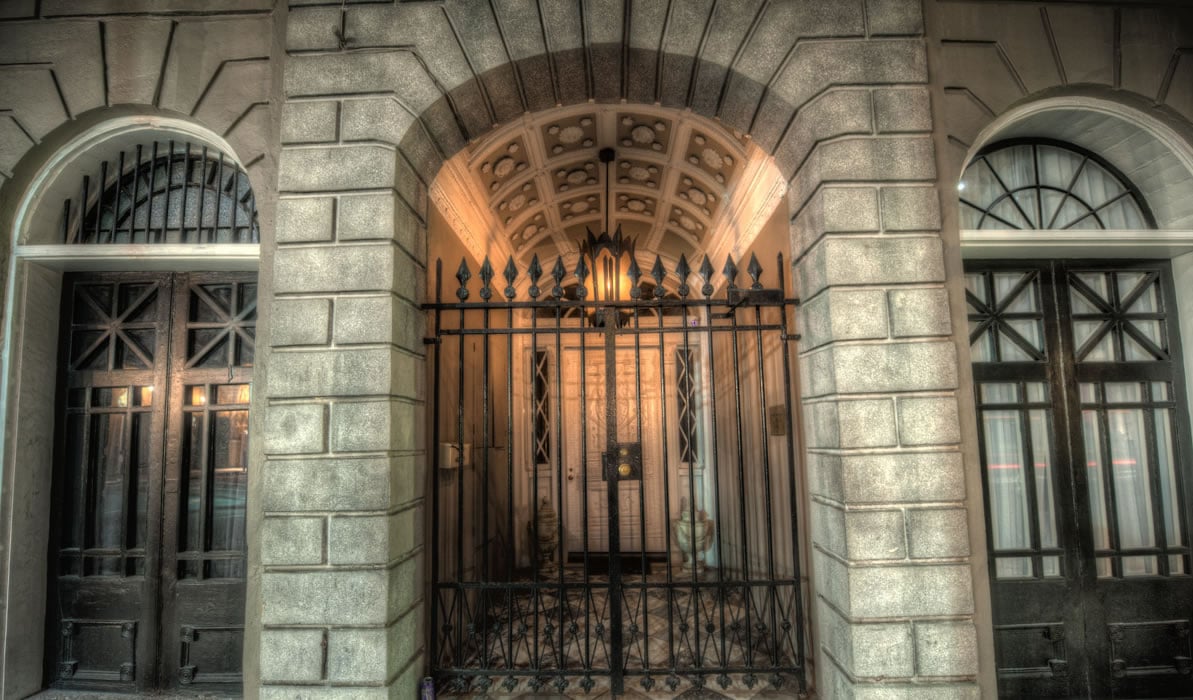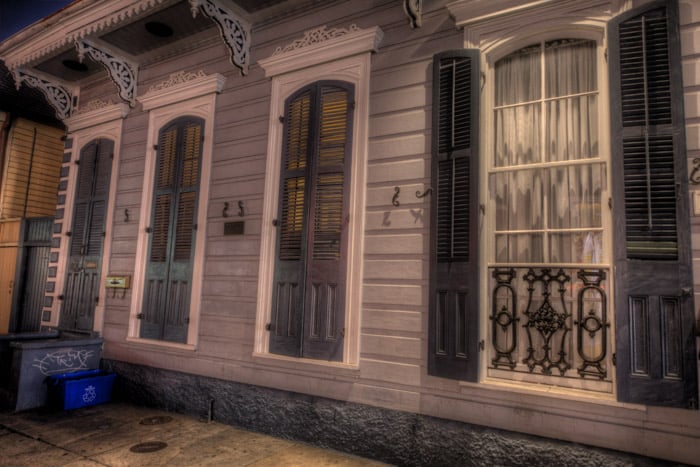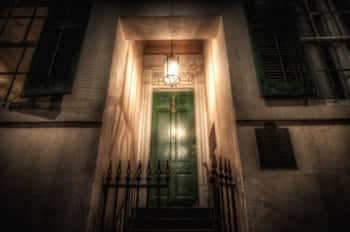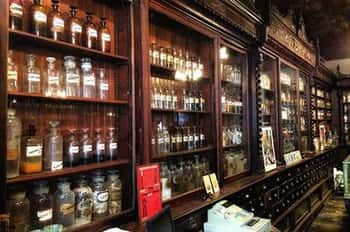
Let’s be honest: American Horror Story Season 3 (more commonly referred to as “Coven”) might just be the show’s most liked season. Maybe it was the dark allure of witches and magic that consumed the country when Coven first aired. Maybe it was simply that New Orleans is that essential blend between the mysterious and the otherworldly.
Whatever that “maybe” might be, there’s one thing for sure: American Horror Story’s Coven swept the country off its feet and cracked open the seal on some of New Orleans’ most vibrant historical figures.
Suddenly, the Voodoo Queen Marie Laveau and the murderous Madame Delphine LaLaurie were mingling together in society—and Delphine was slathering herself in blood to maintain her youth appearance. The Axeman, New Orleans’ notorious serial killer, was engaging in trysts. And, Delphine’s family? They’d been turned into Zombies.
(We all know that Zombies had to pop up somewhere).
American Horror Story put these figures on the media map, even though women like Marie Laveau and Delphine LaLaurie are two of the most well-known names in New Orleans, and have been for two centuries now.
So, who were the cast of characters who were featured in Coven? You might have thought you knew who they were, but I’m here to tell you . . . the history is so much stranger than the fiction composed for TV.
And I haven’t even mentioned their ghosts, which are said to still haunt the French Quarter. (You didn’t think that death would stop this group, did you?)
Delphine LaLaurie hadn’t always slathered herself in blood in the name of beauty—and, in reality, this probably would never have happened. (Weird make up tricks did include bella donna, a poisonous plant used to dilate the eyes or “clear” skin from blemishes, however). She also would never have interacted with Marie Laveau, as they existed at different ends of society’s stratified spectrum.
Delphine was a beauty in her day. The kind of woman who other ladies envied, and men wished to marry. (It didn’t help matters that her family was filthy rich). She would marry three different men in her lifetime, as the first two died quite suddenly. And the third? Well, Dr. Louie Leonard LaLaurie married Delphine on account of the fact that he’d knocked her up. No matter, Delphine was smitten by her much younger husband and wrangled the marriage to her liking.
Unfortunately, Louie never truly liked his wife. They argued quite fiercely at their home at 1140 Rue Royal, so much so that their furious words could be heard to passerby on the street. Louie did not last too long, and in 1834 he separated from Madame Delphine and moved out of their grand house. Delphine was not pleased. The story goes that she took out her frustrations on the enslaved people working inside of her house. It was not the first time that she’d done so, and it was not the first time that governing council of the city had to take a firm hand with her.
But on April 10, 1834, Delphine’s world would come shattering down around her. A fire had started at her home, and men had arrived to put out the conflagration. They motioned to go up the stairs to rescue the enslaved, who had yet to escape the rapidly spreading flames, and Delphine made her first mistake. She told them no, strictly informing them to mind their own business.

That was not to be done. The men rushed into the house, breaking down the doors and hurrying up the stairs to the servant’s quarters. What they found stopped them in their tracks, their stomachs curling at the sight as a few of the men actually twisted at the waist and vomited. “Seven slaves more or less horribly mutilated, were seen suspended by the neck, with their limbs apparently stretched and torn from one extremity to the other” (The Evening Post, New York, 26 April 1834). The New Orleans Bee mentioned other travesties: their skin peeled back like the core from an apple, a woman whose limbs had been broken so that she could fit into a box, the genital-swapping experiments that had been atrociously committed.
Delphine LaLaurie fled the city that night and never returned. Not in her physical body, at least. The LaLaurie Mansion is reputedly so paranormally active that it is often referred to as the Haunted Mansion. When the property was an all-girls school in the late 1800s, many of the girls bared their arms to their teachers only to reveal bloody red scratches etched into their skin. When it was an apartment building in the early 1900s, a man reportedly heard voices telling him to kill himself—he committed suicide on the third floor where he lived.
The newspapers labeled Delphine LaLaurie “a demon in the shape of a woman.” Is it her spirit still haunting the mansion, or her countless victims? Want to read more about Madame Delphine LaLaurie? The truths, the legend, and the real hauntings? Follow this link.
In American Horror Story, Marie Laveau was responsible for giving good old Delphine LaLaurie an immortality elixir before murdering the LaLaurie family and burying Delphine alive. Then, Marie imprisons Delphine and hacks off her hand. (TV is great, y’all).
Marie Laveau in historical reality might have been responsible for giving someone an immortality potion, but her skills as a voodoo priestess far exceeded that.
After all, she was the leading Voodoo practitioner in New Orleans after she usurped that role from her teacher, Dr. John, who was allegedly an African prince from Senegal. Marie dealt in all sorts of magic, or the occult. She read people’s fortunes, the good, the bad, and the ugly. She blended items to help others: herbs for sickness and health, bones of a spider or blood of a chicken for wealth or ambition. These charms, or Gris-gris, were to be kept on your person at all time.
Some claim her to be a hairdresser, although this is probably unlikely. Others say that she had a liquor importing business, thanks to a single newspaper article referencing her as such. She may have been these things, but what is absolutely certain is that Marie knew her position entitled her to a lot of power.
She held Voodoo rituals in Congo Square, now Louis Armstrong Park, to connect with the Loas, or spirits, who could then connect her with Voodoo herself. So well-known was she throughout New Orleans that she charged admittance fees to the aristocrats who desired to come watch these rituals be performed at the park. A good business woman, Marie very much was.

But with that power came rumors of evil and death. Those in the city wondered how she knew everything that she did—how her predictions always manifested in the truth—and many began to fear her.
Her death in 1881 only cemented this image of the legendary Voodoo Queen. Buried as she was in St. Louis Cemetery #1, it was not but a day later that the citizens of the city began to see her meandering through the streets of the French Quarter. They whispered about her youthful vigor, how she had risen from the dead. She was seen for a grand total of 150 years, and the New Orleanians?
They believed that Marie Laveau, the famed Voodoo Queen, was immortal.
She wasn’t: her daughter, Marie II, had taken her mother’s position and her identity and continued on as Marie Laveau I.
To this day, Marie’s spirit is still seen wandering up and down St. Anne Street in the French Quarter by her old house. Her spirit is known to be quite unfriendly at her tomb in St. Louis Cemetery #1; scratching, pushing, punching people who fail to respect her or her beliefs. Are these paranormal occurrences the result of Marie I, however, or Marie II?
As for the paranormal activity occurring within the Laveau’s old house . . . well, that’s a story for another day.
Thinking of the legendary serial killer, the Axeman, having any sort of romantic relationship is a bit like seeing a piranha and thinking to yourself, “Perfect. Totally going to stick my finger in its mouth and see if its teeth are as sharp as they appear.”
You just don’t do it.
But in Coven, that’s exactly what happens when the Axeman is summoned by a ouija board to have a romantic liaison with one of the other characters. Matters complicate themselves. The end point is: Don’t do it with a serial killer, especially not with a murderer who used axes to butcher his prey.
It was the late 1910s when the Axeman surfaced as a problem in New Orleans. Some suggest that he was Jack the Ripper from London, who found himself in New Orleans. (Highly unlikely). Others claim that he was not even human at all, but a dark supernatural being who wreaked havoc on New Orleans. But what is absolutely understood is that the Axeman was meticulous.
He was known to approach his victim’s houses in the dead of night when law-abiding citizens were well asleep. Creeping up to the back doors to steal inside, he used a chisel to cut a panel by the doorknob, removing just enough of the wood so that his hand could fit through. He’d turn the knob, proceed inside. Taking an axe, one that was generally the property of his victim’s, the Axeman proceeded to bludgeon and butcher his victims. He always left the bloody axe behind like a grisly calling card that needed no introduction.
New Orleans erupted in terror. The police force led city-wide manhunts, but there were very few leads. A man dashing beyond a fence. Stories from a few of the victims, who miraculously managed to survive the attacks. No one could deduce the identity of the serial killer, and his unknown face heightened the tension even more.
And then, on March 13, 1919, he wrote a letter to the editor of the Times-Picayune. He was a spirit and a demon sent from Satan . . . and also a lover of Jazz. In his dastardly letter, he wrote, “Now, to be exact, at 12:15 (earthly time) on next Tuesday night, I am going to pass over New Orleans. I am very fond of jazz music and I swear by all the devils in the nether regions that every person shall be spared in whose home a jazz band is in full swing.”
Everyone played jazz. Musicians were rented out, even those who had never had a gig in their entire life, and jazz halls filled to the brim as New Orleans’ citizens swarmed any location who played the Axeman’s preferred music of choice. For a time, no murders took place. Until August that is, and then the last murder in October of 1919.
Who was the Axeman? Theories abound. Almost all of his victims were Italian-Americans, and some question if the Axeman had targeted those connected with the mafia in some way. Was it not a single person who committed all of these crimes, but a group who sought nothing but blood and dismemberment from their victims?
Or maybe the Axeman spoke the truth, and he was simply “the worst demon that ever existed either in fact or in the realm of fancy?”
Papa Legba isn’t the one to cross. The characters on Coven saw that when they crossed him, and he then banished them all to Hell. (It’s quite important to note that Papa Legba is not the Devil).
In the New Orleans Voodoo Religion, Papa Legba is the gatekeeper to the Loas (spirits). When he appears to you, he does so as an old man using a cane, wearing a straw hat and smoking a pipe or perhaps sprinkling water. And much like St. Peter in Catholicism, he controls the gates completely, therefore determining who is allowed permission to speak with the spirits.
Within New Orleans Voodoo, Legba is possibly the most important Loa in the pantheon. He is said to be fluent in all languages, especially in that way of communicating with the spirits. And for those seeking him, he is most commonly found a crossroads; cemetery gates; doorways; or corners.
But if you are hoping to connect with him, be prepared to barter something or offer him something. Rum. Coffee. Three shiny pennies. These items are particularly sacred to him. Once the offering is made, it is up to Papa Legba if he wishes to grant you your wish—and if he perhaps isn’t feeling it that way, you are strictly out of luck.
Luck may very well be on your side, however, for as much of a trickster as Papa Legba can be, he is commonly seen as a happy loa who seeks to aid others in return for veneration and respect.
Is he the Devil in disguise that American Horror Story portrayed him as? Not at all.
As those who practice Voodoo say: “Papa Legba the bone is in the yard.”
And hopefully Legba will open the way.
I’ll be honest with you, many people who come on our Ghost City Tours Ghost Tours in New Orleans are diehard fans of American Horror Story. We’re not upset about this, if only because Coven gave a chance for integral New Orleans history or religion to hit the mainstream.
Did American Horror Story maybe get carried away with their storytelling? Absolutely, but it is TV so could anything else be really expected?
If nothing else, Coven gave us a chance to really dig deep and talk about these historical and religious figures. Who was Delphine LaLaurie and did she really do all that was reported? Would have Papa Legba actually banished people to Hell? (No).
But lucky for you, if you want to learn more about these figures then taking one of our Ghost Tours in New Orleans is the best way to do it. We break down the legends to deliver you the truth, so what better way to fill your American Horror Story fanhood by joining us on one of our tours and visiting the actual locations where we discuss and show you where they might have lived.
Voila:
Ghosts of New Orleans Tour (LaLaurie Mansion)
Killers and Thrillers Tour (LaLaurie Mansion or Hermann-Grima House)
The Bad Bitches of New Orleans Ghost Tour (Old Laveau House)
*Interesting Fact: None of the murders took place in the French Quarter! However, if you are into true crime with a dark paranormal twist, I highly suggest Killers and Thrillers Tour.
Have fun, ya'll, and hopefully American Horror Story will revisit New Orleans and give us Coven V2. We can think of a few New Orleans characters we'd suggest to them...

Was this the site of a grizzly mass murder?

New Orleans' most haunted Cemetery

Who haunts this museum, and why?